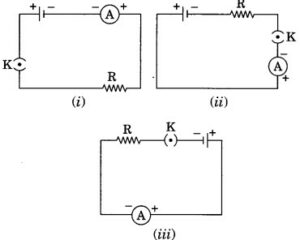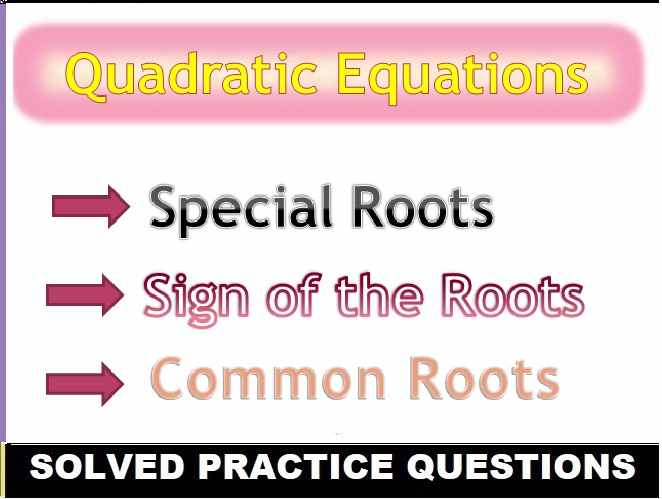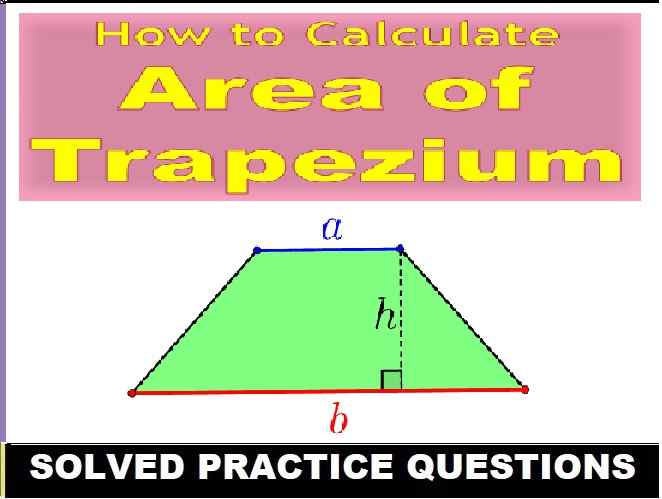MCQ Current Electricity Class-10 for ICSE Physics Sec-A Sem-2 . These MCQ / Objective Type Questions is based on latest reduced syllabus according 2021-22 session on bifurcated pattern. Main motto of MCQ Type Question is cracking the next upcoming Sem-2 exam of council. Visit official website CISCE for detail information about ICSE Board Class-10 Physics .
MCQ Current Electricity Class-10 for ICSE Class-10 Sec-A Sem-2

| Board | ICSE |
| Class | 10th (X) |
| Subject | Physics |
| Chapter | Current Electricity |
| Syllabus | on bifurcated syllabus (after reduction) |
| Session | 2021-22 |
| Bifurcated | Sem-2 |
| Topic | MCQ / Objective Type Question for Sec-A |
Sec-A Sem-2 ICSE Class-10 Physics MCQ Type Questions of Current Electricity
1. If the current flowing through a fixed resistor is halved, the heat produced in it will become:
(a) One-fourth
(b) One-half
(c) Double
(d) Four times
Answer: (a) One-fourth
2. You are given four ammeters A, B, C and D having least counts mentioned below:
(I) Ammeter A with least count 0.25 A
(II) Ammeter B with least count 0.5 A
(III) Ammeter C with least count 0.05 A
(IV) Ammeter D with least count 0.1 A
Which of the ammeters would you prefer for doing an experiment to determine the equivalent resistance of two resistances most accurately, when connected in parallel?
(a) Ammeter A
(b) Ammeter B
(c) Ammeter C
(d) Ammeter D
Answer: (c) Ammeter C
3. In parallel combination, the equivalent resistance obtained is
(a) Grater than each individual resistance
(b) Less than each individual resistance
(c) Equal to each individual resistance
(d) None
Answer: (b) less than each individual resistance
4. If the resistors R1 and R2 connected in parallel then their equivalent resistance is
(a) 1/Re= 1/R1 + 1/R2
(b) Re= R1*R2/ (R1+R2)
(c) Re= R1 + R2
(d) Both a and b
Answer: (d) both a and b
5. The S.I. unit of power is
(a) Henry
(b) coulomb
(c) watt
(d) watt-hour
Answer: (c) watt
6. Electric pressure is also called
(a) resistance
(b) power
(c) voltage
(d) energy
Answer: (c) voltage
7. The least resistance obtained by using 2 Ω, 4 Ω, 1 Ω and 100 Ω is
(a) < 100 Ω
(b) < 4 Ω
(c) < 1 Ω
(d) > 2 Ω
Answer: (c) < 1 Ω
8. Work of 14 J is done to move 2 C charge between two points on a conducting wire. What is the potential difference between the two points?
(a) 28 V
(b) 14 V
(c) 7 V
(d) 3.5 V
Answer: (c) 7 V
9. A wire of length ‘L’, made of material resistivity ‘ρ’ is cut into two equal parts. The resistivity of the two parts are equal to,
(a) Ρ
(b) P/ 2
(c) 2p
(d) P2
Answer: (a) P
10. Insulators have :
(a) No resistance
(b) High resistance
(c) Small resistance
(d) Variable resistance
Answer: (b) High resistance
11. Which of the given is the SI Unit of Electric Current?
(a) Ohm
(b) Ampere
(c) Volt
(d) Faraday
Answer: (b) Ampere
12. The hindrance presented by material of conductor to the smooth passing of electric current is known as:
(a) Resistance
(b) Conductance
(c) Inductance
(d) None of these
Answer: (a) Resistance
13. A wire of length /, made of material resistivity ρ is cut into two equal parts. The resistivity of the two parts are equal to,
(a) ρ
(b) 𝜌/2
(c) 2 ρ
(d) 4 ρ
Answer: (a) ρ
14. A battery of 10 volt carries 20,000 C of charge through a resistance of 20 Ω. The work done in 10 seconds is
(a) 2 × 103 joule
(b) 2 × 105joule
(c) 2 × 104 joule
(d) 2 × 102 joule
Answer: (b) 2 × 105joule
15. To get 2 Ω resistance using only 6 Ω resistors, the number of them required is
(a) 2
(b) 3
(c) 4
(d) 6
Answer: (b) 3
16. Two devices are connected between two points say A and B in parallel. The physical quantity that will remain the same between the two points is
(a) current
(b) voltage
(c) resistance
(d) None of these
Answer: (b) voltage
17. The least resistance obtained by using 2 Ω, 4 Ω, 1 Ω and 100 Ω is
a) < 100 Ω
(b) < 4 Ω
(c) < 1 Ω
(d) > 2 Ω
Answer: (c) < 1 Ω
18. Unit of electric power may also be expressed as
(a) volt ampere
(b) kilowatt hour
(c) watt second
(d) Joule second
Answer: (a) volt ampere
19. Electrical resistivity of a given metallic wire depends upon
(a) its length
(b) its thickness
(c) its shape
(d) nature of the material
Answer: (d) nature of the material
20. A cell, a resistor, a key and ammeter are arranged as shown in the circuit diagrams of Figure (i), (ii) and (iii). The current recorded in the ammeter will be

(a) maximum in (i)
(b) maximum in (ii)
(c) maximum in (iii)
(d) the same in all the cases
Answer: (d) the same in all the cases
20. 1 kWh is equal to
(a) 3.6 × 106 MJ
(b) 3.6 × 105 MJ
(c) 3.6 × 10² MJ
(d) 3.6 MJ
Answer: (d) 3.6 MJ
21. The slope of voltage (V) versus current (I) is called

(a) resistance
(b) conductance
(c) resistivity
(d) conductivity
Answer: (a) resistance
22. Electricity Class 10 MCQ With Answers Pdf Question 11. Calculate the current flows through the 10 Ω resistor in the following circuit.

(a) 1.2 A
(b) 0.6 A
(c) 0.2 A
(d) 2.0 A
Answer: (b) 0.6 A
23. Two resistors are connected in series gives an equivalent resistance of 10 Ω. When connected in parallel, gives 2.4 Ω. Then the individual resistance are
(a) each of 5 Ω
(b) 6 Ω and 4 Ω
(c) 7 Ω and 4 Ω
(d) 8 Ω and 2 Ω
Answer: (b) 6 Ω and 4 Ω
24. If R1 and R2 be the resistance of the filament of 40 W and 60 W respectively operating 220 V, then
(a) R1 < R2
(b) R2 < R1
(c) R1 = R2
(d) R1 ≥ R2
Answer: (b) R2 < R1
25. The effective resistance between A and B is

(a) 4Ω
(b) 6Ω
(c) May be 10 Ω
(d) Must be 10 Ω
Answer: (a) 4Ω
26. A resistor of length l is connected to a battery and current l is given through it. If it is divided into 3 parts by length. And all having the same cross sectional area are connected in series with the same battery, the current flowing through them will be?
(a) l/3
(b) 3l
(c) l
(d) 3l/2
Answer: (c) l
27. Two resistances R1 and R2 are connected with a cell in parallel. Find the ratio of current flowing through R1 to the current flowing through R2.
(a) R1:R2
(b) R2:R1
(c) 1.01
(d) Data not sufficient
Answer: (b) R2:R1
28. A student carries out an experiment and plots the V-I graph of three samples of Nichrome wire with resistances R1 R2 and R3 respectively. Which of the following is correct?

(a) R1 = R2 = R3
(b) R1 > R2 > R3
(c) R1 < R2 > R3
(d) R1 < R2 < R3
Answer:(d) R1 < R2 < R3
29. The resistance of a hollow cylinder of copper of length 10 m and inner and outer radii 2cm and 3 cm respectively is (ρ copper = 2 ×10-8 Ω m):
(a) 2/ π × 10-3 Ω
(b) 2/5 π × 10-3 Ω
(c) 2/5 × 10-3 Ω
(d) None of the above
Answer: (b) 2/5 π × 10-3 Ω
30. The resistance whose V – I graph is given below is

(a) 5/3 Ω
(b) 3/5 Ω
(c) 5/2 Ω
(d) 2/5 Ω
Answer: (b) 3/5 Ω
31. A resistance having rating 10 ohms, 10 W is likely to be a
(a) metallic resistor
(b) carbon resistor
(c) wire wound resistor
(d) variable resistor
Answer: (c) wire wound resistor
32. Which one of the following does not have negative temperature co-efficient ?
(a) Aluminium
(b) Paper
(c) Rubber
(d) Mica
Answer: (a) Aluminium
33. Varistors are
(a) insulators
(b) non-linear resistors
(c) carbon resistors
(d) resistors with zero temperature coefficient
Answer: (6) non-linear resistors
34. 1V=
(a) 1V = 1J*1C
(b) 1V= 1J/1C
(c) 1V= 1C + 1J
(d) 1V = 1C – 1J
Answer: (b) 1V = 1J/1C
35. An electrical appliance has a resistance of 25 Ω. When this electrical appliance is connected to a 230 V supply line, the current passing through it will be:
(a) 0.92 A
(b) 2.9 A
(c) 9.2 A
(d) 92 A
Answer: (c) 9.2 A
36. If in the given arrangement, the three resistors are to be replaced by a single resistor. What will be the value of this resistor?

(a) 4Ω
(b) 6Ω
(c) 9Ω
(d) 18Ω
Answer: (c) 9Ω
37. The image shows a combination of 4 resistors.

What is the net resistance between the two points in the circuit?
(a) 0.5 Ω
(b) 1.0 Ω
(c) 1.5 Ω
(d) 2.0 Ω
Answer: (b) 1.0 Ω
38. An electric toaster has a power rating of 200 W. It operates for 1 hour in the morning and 1 hour in the evening. How much does it cost to operate the toaster for 10 days at Rs 5 per kW h?
(a) Rs 20
(b) Rs 400
(c) Rs 5000
(d) Rs 10000
Answer: (a) Rs 20
39. The filament of an electric bulb is made of
(a) carbon
(b) aluminium
(c) tungsten
(d) nickel
Answer: (c) tungsten
40. A 3 Q resistor having 2 A current will dissipate the power of
(a) 2 watts
(b) 4 watts
(c) 6 watts
(d) 8 watts
Answer: (c) 6 watts
–: End of Current Electricity MCQ Type Question :-
-: also visit :-
- ICSE Sem-2 Question Bank Class-10
- Sem-2 Specimen / Model / Sample Paper for ICSE Class-10
- ICSE Class-10 Text book Solutions, Notes , Syllabus, Paper, Notes
Please share with your ICSE friends if it is helpful
Thanks


